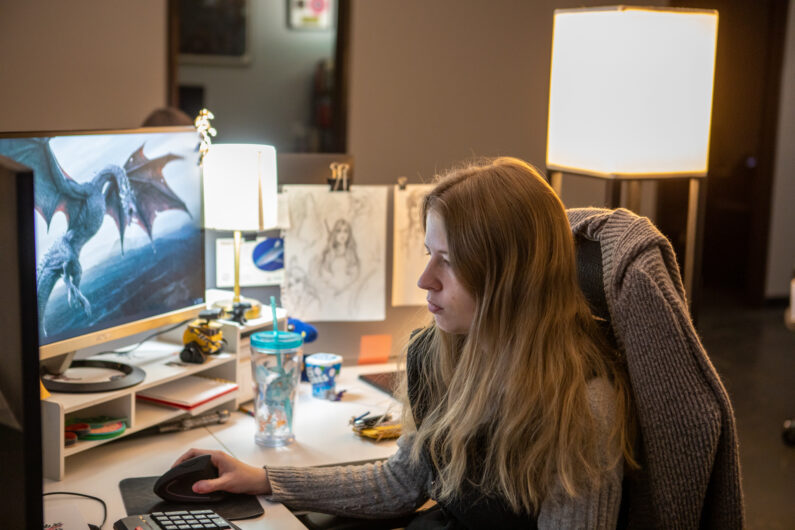- Mach moving tracks the movement of a camera and matches it to computer generated graphic movements.
- This specific technique allows for more complex camera movements such as moving through walls, etc.
- Boiling Point Media is a full service post production company that has experience with maching movie making.
Match moving is a term used in the filmmaking industry to describe the process of accurately matching the movement and position of real-world objects with those of computer-generated graphics. This technique is essential for creating visual effects (VFX) that seamlessly blend into live-action footage, making them appear as if they are part of the real-world environment. Most people are unaware of how the match moving process is done although they unknowingly expect it in every film they watch.
What is Match Moving?
Match moving in filmmaking is a technique used in the VFX industry to track the movement of a camera and match it to the movement of computer-generated graphics. It involves analyzing live-action footage to extract information about the camera’s movement, such as its position, orientation, and field of view. This information is then used to create a virtual camera in the 3D software, which matches the real-world camera movement. Once the virtual camera has been created, the VFX artist can add 3D elements to the scene, and they will appear as if they are part of the real-world environment. It’s pretty amazing when you think about it.
How Does Match Moving Work?
Match moving in filmmaking works by tracking specific points in the live-action footage and using those points to calculate the movement of the camera. The points that are tracked are known as tracking markers, and they can be anything from natural features such as rocks or trees to artificial markers placed on set. The software then uses these markers to create a 3D reconstruction of the scene, which matches the real-world environment.
The match moving process involves several steps, including:
- Tracking Markers: The first step in match moving is to track specific points in the live-action footage. This is usually done using specialized tracking software, which can automatically detect and track the markers.
- Solve Camera Motion: Once the tracking markers have been identified, the software then calculates the camera’s movement and orientation, using the tracked points to reconstruct the camera’s path through the scene.
- Creating A Virtual Camera: The software then creates a virtual camera within the 3D software, which matches the real-world camera movement.
- Adding 3D Elements: Once the virtual camera has been created, the VFX artist can then add 3D elements to the scene, which will appear as if they are part of the real-world environment.
Why is Match Moving Important to the VFX Process?
Match moving is an essential part of the VFX process because it allows VFX artists to seamlessly blend computer-generated graphics into live-action footage. Without match moving in filmmaking, it would be impossible to create convincing VFX, as the 3D elements would appear to be floating in space or moving independently of the real-world environment.
Match moving is also important because it allows filmmakers to create complex camera movements that would be difficult or impossible to achieve in the real world. For example, a virtual camera can be created that moves through walls or flies over buildings, giving filmmakers the freedom to create shots that would otherwise be impossible.
Match Moving Workflow
The match moving workflow typically involves the following steps:
- Pre-Production: In pre-production, the VFX supervisor works with the director and cinematographer to plan the VFX shots and identify any tracking markers that need to be placed on set.
- Production: During production, the tracking markers are placed on set, and the live-action footage is filmed.
- Post-Production: In post-production, the footage is analyzed using match moving software, and the camera’s movement is reconstructed in 3D space. The VFX artist can then add 3D elements to the scene, which will appear as if they are part of the real-world environment.
Ways to Track Motion
There are several ways to track motion, including:
- Point Tracking: Point tracking involves tracking individual points in the footage, such as natural features or artificial markers. The software then uses the position of these points to calculate the camera’s movement.
- Planar Tracking: Planar tracking involves tracking flat surfaces in the footage, such as walls or floors. This technique is useful for tracking objects that move within a specific plane, such as a character walking across a room.
- 3D Tracking: 3D tracking involves tracking the movement of an object in all three dimensions. This technique is useful for tracking objects that move through space, such as a car driving down a road.
- Object Tracking: Object tracking involves tracking the movement of a specific object in the footage. This technique is useful for tracking objects that move independently of the camera, such as a person holding a phone.
Match moving in filmmaking is a complex process that requires a high level of technical expertise and specialized software. The VFX artists and technicians at Boiling Point Media specialize in match moving and compositing as we use these processes in almost every film we produce.
Choose Boiling Point Media for Match Moving & VFX
Looking to produce a film with high quality VFX? Match moving is just one of the VFX & post-production film services we provide for filmmakers. Our film studio in Oklahoma City is fully equipped to produce your film from assistance with script writing, pre-production, filming, and post-production services including VFX, editing, and film coloring. We are even certified in virtual production and the use of Unreal Engine to create amazing environments. Visit our website for more information or give us a call and speak with our Emmy Award winning director. We look forward to making your film idea a reality!
Phone Number:
